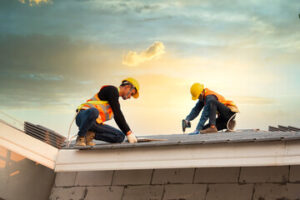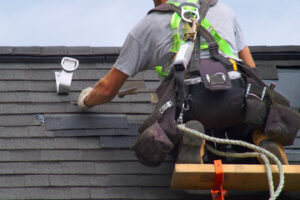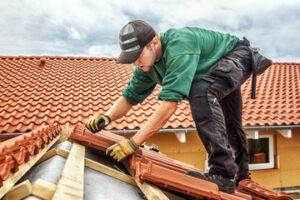There are many things that can damage a roof. It is important to regularly inspect it.

It is also a good idea to check and repair the flashing around chimneys and roof windows. This is a weak spot that can allow water into the home. Contact Corpus Christi Roofing CO for professional help.
Although some repairs are within the capabilities of a handy homeowner, most should be left to the professionals. This is to avoid voiding any warranties and protect the structural integrity of your home.
The roof is an integral part of the home that protects everything inside and adds value to it. Unfortunately, it’s not infallible and requires regular maintenance to prevent issues from getting out of hand. If you want to avoid costly replacement, you need to know how to identify problems that can be fixed with a simple roof repair.
Damaged shingles and tiles are the most common roofing issue. High winds, falling debris, and aging can all loosen or damage shingles and tiles. This can lead to a variety of problems, including leaks, rot in wooden substructures, and mildew and mold growth.
Fortunately, you can prevent most roof issues by regularly inspecting the structure and looking for signs of trouble. A good place to start is with a visual inspection of the shingles and gutters, especially after a storm. Look for curled, missing, or cracked shingles, and examine the flashing around chimneys, skylights, dormers, and vents.
If you have a vaulted ceiling, it’s essential to check the attic at specific intervals for discoloration and water stains. If there are any issues, it’s best to call a professional for a quick inspection and repair.
Leaks can be tricky to detect, as they may manifest at spots distant from the source of the problem. You can try spraying down a ceiling with a hose, but it’s much easier to find the source of the leak by checking for flow stains on the plastic vapor barrier under the drywall.
A professional can also inspect the roof for any shingle and flashing issues that need to be repaired. These can include cracking, blistering, buckling, cupping, or splitting. If these are left unattended, they can lead to moisture penetration, which can cause serious damage.
A roof repair company will also check for clogged gutters, which can lead to problems with siding and foundations. They’ll also assess the presence of moss and other organisms, which can cause leaks, rot, and general structural damage. These organisms thrive in dark and damp areas, and if they get out of control, they can cause serious problems with the wood in your roof’s substructure.
Remove the Old Shingles
If your roof is leaking or showing signs of wear and tear, you need to get it replaced as soon as possible. This is a difficult project to complete on your own, so it’s best to hire professionals to do the job right.
You’ll need to remove all of the old shingles from the roof before you can begin the repairs. Make sure that you have a dumpster and a large tarp nearby to hold all of the debris. It’s also a good idea to have someone on the ground to keep an eye out for falling shingle pieces.
Start by removing the shingles near the roof jacks on the section of the roof you’re working on. Then, work your way down the rest of the roof, removing the shingles and felt paper as you go. You’ll want to work carefully to prevent the shingles from sliding down the roof and tearing up your gutters or causing other damage.
Once you’ve removed the shingles, sweep the area to remove any remaining nails and debris. You may want to cover the bare roof with a self-sticking water and ice barrier to prevent it from getting wet while you’re working on the repairs.
It’s a good idea to have a garden fork on hand as you’re removing the shingles. This tool is specially designed to help you remove shingles easily, with a serrated edge that grabs under the nails and a raised “foot” on the back to add leverage. Using this tool will allow you to remove the shingles without damaging the sheathing beneath them.
Carefully inspect the flashing (the thin strips of metal that direct rainwater away from the house) as you work to determine if it can be reused or if it needs to be replaced. It’s best to replace the flashing as you’re removing the shingles, to ensure that the new shingles will create a water-tight seal with the sheathing underneath.
Inspect the Flashings
The flashings are strips of metal or rubber that create a waterproof barrier at areas where the roof changes planes or penetrations occur, like chimneys, vents and skylights. While roof leaks can also be caused by shingles, vent cracks or poorly sealed valleys, the majority of them begin at the points where different pieces of the roof intersect. For this reason, it is important to regularly check and repair your roof flashings.
A professional roofer will inspect the condition of your roof for signs of leaks, rot and other problems. They will also look at the flashings for issues such as cracking or rust. Since they are a critical component of your roof system, they should be maintained properly to protect the interior of your home from moisture.
Leaks often start in the flashing, so it is especially important to keep an eye on them. If the flashing is leaking or shows signs of damage, it must be repaired immediately.
A common cause of flashing leaks is poor installation. This can be a problem with the flashing itself or the sealant used to secure it.
It is a good idea to hire a professional for this job as it is dangerous to climb on the roof without the proper safety equipment. If you are confident in your own abilities, though, you can inspect the flashings by following the steps below.
First, check the shingle seams for any gaps or overlapping. If there are any, these will need to be caulked. This will prevent water from seeping in between the shingles and into the attic or living space.
Another common issue is the failure of the flashing to adhere to the wall or roof. This is usually caused by the flashing being too narrow for the vent or other item it is covering. It is a good idea to have a professional roofing contractor inspect the flashings on all safely accessible projections from your roof, like chimneys, vents and skylights.
A simple test to identify a leak in the flashing is to run a hose over your roof. If the person in the attic can hear water dripping, it is likely the flashing is leaking or not fastened properly.
Clean the Area
As you clean the roof, be sure to inspect the area around your gutters and downspouts. They should be free of debris and in good working condition so they can effectively direct rainwater away from your roof and home. If the gutter system is not functioning correctly, it can result in leaks and other problems down the road.
Also, be sure to examine the flashings around chimneys, skylights and any other roof projections that are located on your home. These areas are vulnerable to water infiltration, especially when the flashing has become corroded. Regular inspection of these areas can prevent them from becoming a major problem.
While you are on the ladder, take a moment to clean the fascia and soffit with a brush and bleach mixture. This will help to keep them in good shape and will also make the entire house look better. Be sure to check for any spots of mould that may have developed on the fascia and soffit over time. If you find any, then it is a sign that the roof is leaking and should be repaired by a professional.

